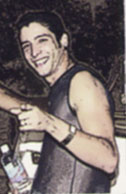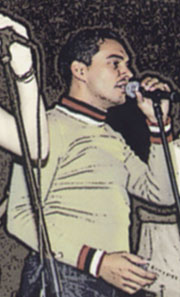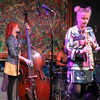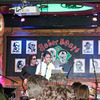Indice - Table of contents
New Stuff[hide]
Staff: Bill Tilford
Reportes: From The St... : Jazz Plaza ...
Fotos: Tom Ehrlich : Irakere 50th Annivers...
Fotos: Tom Ehrlich : Irakere
Resenas: Joey Altruda Presents: El Gran ...
Timbapedia: 09. Interviews -... : Carlos del Pino ...
Fotos: Tom Ehrlich : 2023 Monterey Jazz Fe...
Fotos: Tom Ehrlich : 2023 Monterey Jazz Fe...
Fotos: Tom Ehrlich : 2023 Monterey Jazz Fe...
Fotos: Tom Ehrlich : 2023 Monterey Jazz Fe...
Grupos: Tirso Duarte
Grupos: Tirso Duarte : Discography
Grupos: Charanga Habaner... : 8. El bla bla bla
Grupos: Pupy y los que S... : Tirso Duarte
Photos of the Day [hide]
SpanishEnglishDiscography - El puente - Ellas son las que son
Ellas son las que son
Like the song El puente, Ellas son las que son is a work in progress, but it's much farther along. Parts of it have shown up in various transitional arrangements which Manolín played live in Cuba. The key components are:
1) A great piano tumbao/coro sequence with two different coros, both very catchy. [audio example 11] and [audio example 12]
2) A horn phrase which started out as a rhythmically displaced quote of Queen's "Another One Bites the Dust", which happens to be the theme song of a popular late afternoon show on Radio Taíno in Havana. By the time of the El puente concert most of the quote had disappeared and been replaced by original material, and you probably wouldn't think of "Another One Bites the Dust" if you hadn't heard the earlier sketches. [audio example 13] Before leaving Cuba, the band was also conducting mambo experiments based on the Rolling Stones' "Bitch", and if (ahem) the band continues to work together, it should be interesting to see if and how any of that makes its way to the surface.
3) A nice melodic cuerpo, the last line of which Manolín has never learned to sing! He seems to miss a different note every time, and inexplicably, the current arrangement keeps bringing that part back over and over! It leads directly to the great piano tumbao heard in audio example 11 and Manolín repeats it 3 or 4 times on the recording...like Sisyphus trying to push his rock up the mountain. After the line that Manolín messes up, there's a potentially beautiful, but very difficult part that the coristas usually mess up even worse (I'm not kidding about this) but since since the coros are overdubbed on "El puente", we finally have a good recording of that part.

 In fact, all of the coros on this album are excellent, thanks in part to the careful studio overdubs, which allowed Manolín's brother Lázaro (right) and Joaquín "El Kid" Díaz (left) to achieve a perfect blend and excellent intonation. As anyone who's every played in a salsa band can tell you, it's brutally hard to get nice 3-part harmonies right in concert unless you have the prohibitively expensive in-ear monitoring system that rich folk like Willie Chirino and Luis Enrique use. The use of wedge monitors at Rancho Gaspar and the resulting bleedthrough is also the reason that Reinier's crash cymbal sounds so strange in the mix. I'm still fond of the mix overall though -- the coros, bass, and congas are sublime.
In fact, all of the coros on this album are excellent, thanks in part to the careful studio overdubs, which allowed Manolín's brother Lázaro (right) and Joaquín "El Kid" Díaz (left) to achieve a perfect blend and excellent intonation. As anyone who's every played in a salsa band can tell you, it's brutally hard to get nice 3-part harmonies right in concert unless you have the prohibitively expensive in-ear monitoring system that rich folk like Willie Chirino and Luis Enrique use. The use of wedge monitors at Rancho Gaspar and the resulting bleedthrough is also the reason that Reinier's crash cymbal sounds so strange in the mix. I'm still fond of the mix overall though -- the coros, bass, and congas are sublime.
The first minute of track 6 consists of Manolín and the crowd muddling through one of the best songs from his second album, Te conozco mascarita. Manolín sings the cuerpo and then each coro, getting gradually more and more off key, and then, just as the band starts to come in, he changes songs and begins another a capella adventure -- also in the wrong key -- Manolín always seems to enter in the key of G even though most of his songs are in F or Ab. But in this case, we'll have to forgive him, because the song he introduces is the one everyone has been waiting for since 1999 -- Dios sabe a quien le da, Dios sabe a quien le quita -- and from this point onwards, the horsing around is over. The next nine songs are all Timba classics and the band hammers each one home with the energy of a stadium rock concert encore.























